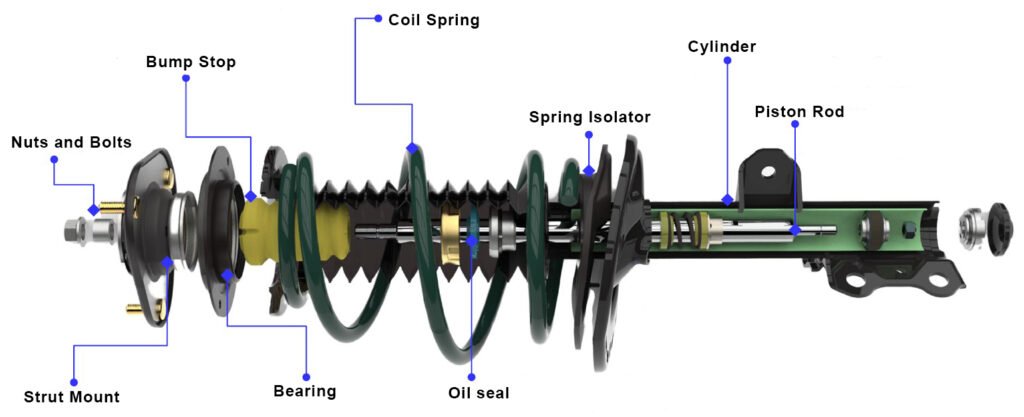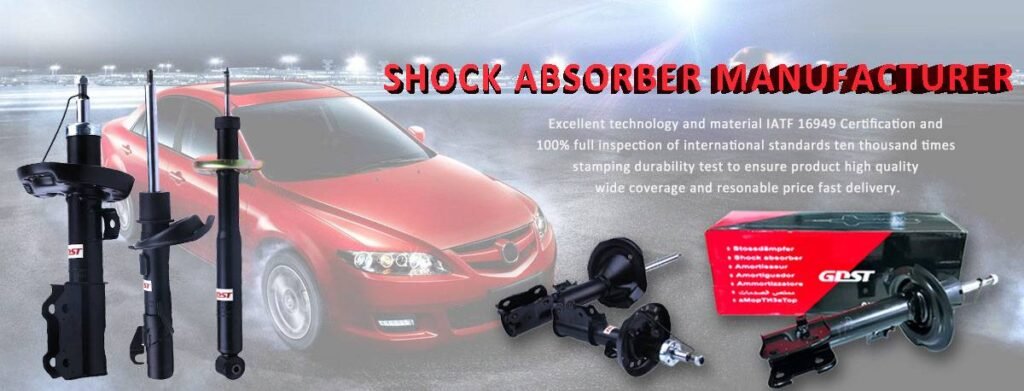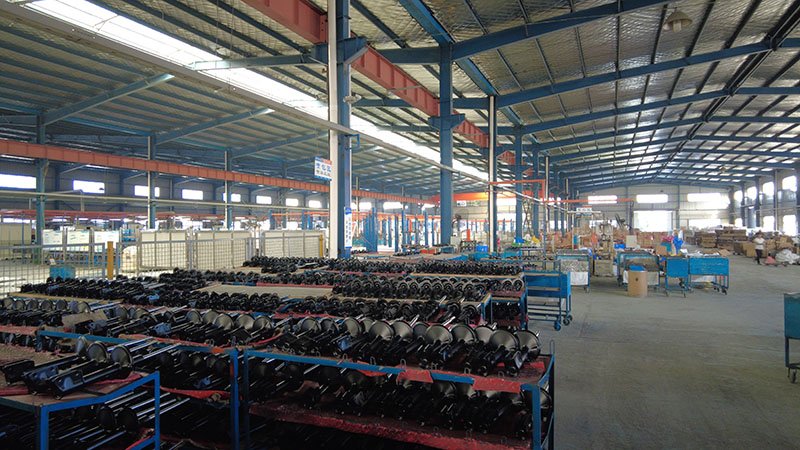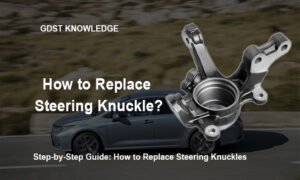When driving on bumpy roads, a good shock absorber can make all the difference in providing a comfortable ride. However, with so many brands and models of shock absorbers available, it can be difficult to know how to choose the right one. So, how do you select a shock absorber that is best suited to your needs? In this article, we will explore some questions to know more about shock absorbers and consider when choosing a shock absorber, ensuring that you have a smoother and more comfortable driving experience. Last time, we introduced the types and functions of shock absorbers. This time, we will mainly introduce the structure, maintenance, and how to choose the right shock absorbers.
What are the components of a shock absorber?
A shock absorber consists of several components, each of which plays a critical role in absorbing shocks and maintaining vehicle stability, helping to reduce the effects of shock and vibrations by converting kinetic energy into thermal energy. Here are some of the main components of a shock absorber:

- Mounting hardware: the set of brackets, bolts, and bushings that attach the shock absorber to the vehicle or machinery. It is designed to provide a secure and stable connection between the shock absorber and the frame or axle.
- Strut Mount: a component of a suspension system that connects the strut assembly to the vehicle’s body or frame. It is typically made of rubber or a combination of rubber and metal and serves as a buffer between the strut assembly and the vehicle’s body.
- Oil Seal: to prevent the hydraulic fluid from leaking out of the shock absorber. It is typically made of a flexible material such as rubber and is designed to fit snugly around the piston rod or other moving parts of the shock absorber.
- Piston: a cylindrical component that moves inside the shock absorber cylinder. It is attached to the piston rod and has a series of holes or slots that allow hydraulic fluid to flow through it. When the piston moves up and down, it compresses and expands the hydraulic fluid, creating a damping force that absorbs shock.
- Cylinder: a long, thin tube that houses the piston and hydraulic fluid. It is typically made of steel or aluminum and is designed to withstand high pressure and temperature.
- Hydraulic Fluid: a specially formulated oil that is used to dampen the movement of the shock absorber piston. It flows through the piston and cylinder, absorbing energy and converting it into heat energy.
- Piston Rod: a long, thin rod that connects the piston to the mounting point of the shock absorber. It is made of high-strength steel or other materials and is designed to withstand high stress and pressure.
- Valving: a set of small metal disks or plates that control the flow of hydraulic fluid through the piston. They are designed to provide different levels of damping force depending on the speed and intensity of the shock.
- Bump Stop: a rubber or plastic component that is attached to the top of the shock absorber. It helps to limit the movement of the shock absorber when it reaches its maximum compression or extension.
Overall, each component of a shock absorber plays a critical role in ensuring that the device can effectively absorb shock and maintain vehicle stability. By working together, these components help to reduce the effects of bumps, potholes, and other road irregularities, and provide a smoother and safer driving experience.
How to do maintenance for shock absorbers?

Maintenance of shock absorbers is essential to ensure their optimal performance and longevity. Here are some steps you can follow to maintain your shock absorbers:
- Check for Leaks: The first step in shock absorber maintenance is to check for any signs of leaks. Look for wet or oily spots around the shock absorber cylinder, piston, or mounting hardware. If you notice any leaks, it is a sign that the shock absorber needs to be repaired or replaced.
- Inspect Rubber Bushings: The rubber bushings that attach the shock absorber to the vehicle or machinery can wear out over time, causing the shock absorber to become loose or unstable. Inspect the rubber bushings for any signs of wear or damage and replace them if necessary.
- Check for Wear and Damage: Inspect the shock absorber’s components, including the piston, cylinder, valving system, and mounting hardware, for any signs of wear or damage. Look for cracks, dents, or other types of damage that could affect the shock absorber’s performance.
- Clean the Shock Absorbers: Dirt, debris, and road grime can accumulate on the shock absorber’s surface, reducing its effectiveness. Clean the shock absorbers regularly using mild detergent and water. Avoid using harsh chemicals or solvents, as they can damage the shock absorber’s components.
- Lubricate Moving Parts: The piston and cylinder of the shock absorber move against each other, creating friction that can lead to wear and tear. Lubricate the shock absorber’s moving parts with a silicone-based lubricant to reduce friction and prolong the shock absorber’s life.
- Replace Worn-Out Parts: If you notice any signs of wear or damage during your inspection, replace the worn-out parts immediately. Replacing worn-out parts can improve the shock absorber’s performance and prevent further damage.
- Follow the Manufacturer’s Guidelines: Finally, always follow the manufacturer’s guidelines for maintaining your shock absorbers. The manufacturer may recommend specific maintenance intervals, procedures, or products that are necessary for optimal performance and longevity.
By following these steps, you can ensure that your shock absorbers are well-maintained and performing at their best. Regular maintenance can also help to prevent costly repairs or replacements down the line.
How to Choose the Right Shock Absorbers?

Choosing the right shock absorbers is important to ensure your vehicle or machinery is stable, safe, and comfortable to ride. Here are some factors to consider when choosing the right shock absorbers:
- Vehicle or machinery type: Different types of vehicles or machinery require different types of shock absorbers. For example, heavy-duty trucks require heavy-duty shock absorbers, while light-duty cars require lighter shock absorbers.
- Driving conditions: Consider the typical driving conditions you encounter. If you drive mostly on smooth highways, you may not need heavy-duty shock absorbers, but if you frequently drive on rough terrain, you may need more durable shock absorbers.
- Load capacity: Consider the weight of the vehicle or machinery and the load it carries. If you carry heavy loads or tow trailers, you may need shock absorbers with higher load capacity to handle the added weight.
- Type of suspension system: The type of suspension system in your vehicle or machinery can also affect the choice of shock absorbers. For example, some suspension systems may require shock absorbers with a specific mounting style or length.
- Type of shock absorber: There are different types of shock absorbers, including hydraulic, gas, and air shock absorbers. Hydraulic shock absorbers use hydraulic fluid to dampen the shocks, while gas shock absorbers use pressurized gas to absorb shocks. Air shock absorbers use compressed air to adjust the stiffness of the suspension system.
- Quality and brand: Choose a reputable brand and high-quality shock absorbers to ensure long-lasting performance and reliability.
- Personal preferences: Consider your personal preferences, such as ride comfort, handling, and noise level. Some shock absorbers may provide a stiffer or more comfortable ride, depending on your preferences.
In summary, choosing the right shock absorbers involves considering factors such as the type of vehicle or machinery, driving conditions, load capacity, suspension system, type of shock absorber, quality and brand, and personal preferences. By considering these factors, you can make an informed choice and ensure a safe, comfortable, and reliable ride.

GDST shock absorber factory has more than 20 years of rich production experience, producing more than 4000 models, and has built its reputation around the world on this tradition of consistent quality, advanced technology, and competitive price.
GDST manufactures a wide range of twin-tube shock absorbers and monotube shock absorbers in various sizes, mounting configurations, spring rates, and valve options, all of which can be adjusted to suit your application. Our extensive product range enables you to select the ideal product to provide optimum performance for you and your customers.
Visit the GDST shock absorber manufacturer web: https://goldenstarintl.com/ to get your hands on these cutting-edge shock absorbers today!






